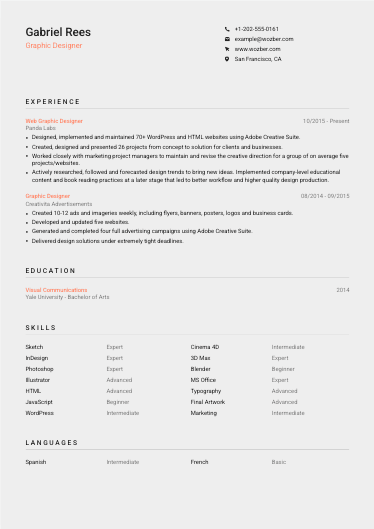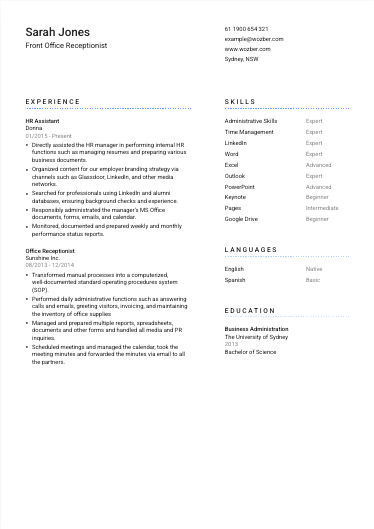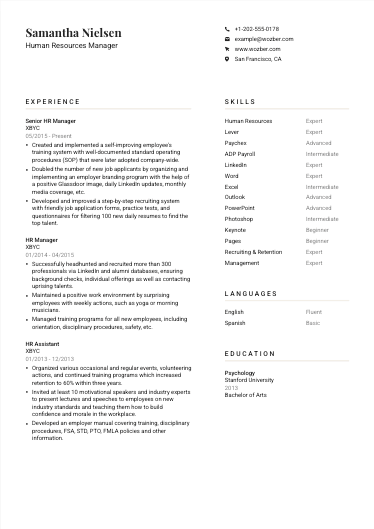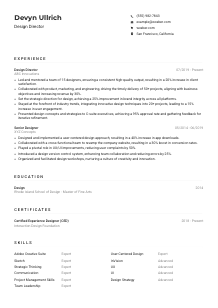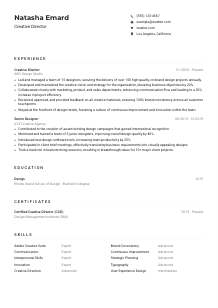Design Manager CV Example
Curating creative strategies, but your CV feels out of the sketchpad? Navigate this Design Manager CV example, stylized with Wozber free CV builder. Grasp how to craft a narrative that showcases your artistic leadership to align with the job requirements, painting a career path that's in vogue and on-brand!
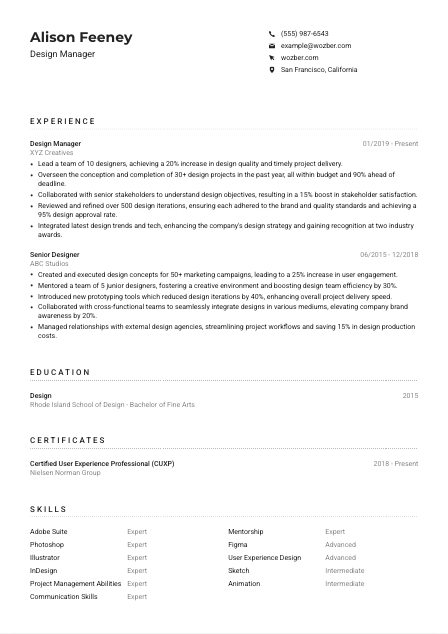
How to write a Design Manager CV?
Venturing into the vibrant realm of design management requires not just a passion for creativity but also a strategically crafted CV that speaks volumes about your expertise and vision. As a Design Manager, your CV is more than a mere document; it's a canvas where you paint your professional journey with precision and flair. Embrace this guide, powered by Wozber's free CV builder, as we navigate the path to tailoring an ATS-compliant CV that mirrors the design manager position you're eyeing.
Ready to transform your professional narrative into a masterpiece? Let's delve into creating a CV that lands you at the design helm!
Personal Details
Even in the digital era, the personal touch is invaluable, especially on your CV. It's your first impression, the subject line to your story. Here, we'll unveil how to fine-tune this section for the Design Manager role, making sure every detail contributes to a vivid, inviting portrayal of your professional persona.
1. Your Name: The Branding Header
Consider your name the logo of your professional brand. It should pop! Use a legible, professional font and let it slightly dominate the header area. This ensures that, amid dozens of CVs, yours stands out with authority.
2. Clarifying Your Role
Directly beneath your name, align with the job title you're pursuing - in this case, "Design Manager." This strategic placement acts like a tagline to your brand, immediately aligning you with the role and setting the stage.
3. Essential Contact Information
Trim down to the essentials - a phone number devoid of typos, a professional email (think firstname.lastname@domain.com), and perhaps a LinkedIn profile. Every piece of contact information is a bridge to potential opportunities, so ensure they're sturdy and clear.
4. Geographical Alignment
Reflecting the job's location in your contact details is a subtle nod to your availability and readiness. For a role requiring you to be "located in San Francisco, California," this detail reassures employers of your logistical fit without a word.
5. Digital Professional Presence
In today's design landscape, your online portfolio or LinkedIn profile can provide a deeper glimpse into your capabilities. Linking to your polished, relevant online presence can elevate your application, giving employers a sneak peek into your design philosophy.
Takeaway
The Personal Details section is akin to the grand entrance at the start of your professional showcase. It's vital to ensure these details are not only accurate but imbued with intention, reflecting the narrative you wish to convey. Step into this journey with confidence, letting every detail pave the path toward that first conversation.





Experience
The substance of your experience is crucial, particularly for a Design Manager role where leadership marries creativity. Let's explore tailoring your experience to not just match but enhance the job specification, transforming your narrative into an engaging story of growth, innovation, and leadership.
- Lead a team of 10 designers, achieving a 20% increase in design quality and timely project delivery.
- Overseen the conception and completion of 30+ design projects in the past year, all within budget and 90% ahead of deadline.
- Collaborated with senior stakeholders to understand design objectives, resulting in a 15% boost in stakeholder satisfaction.
- Reviewed and refined over 500 design iterations, ensuring each adhered to the brand and quality standards and achieving a 95% design approval rate.
- Integrated latest design trends and tech, enhancing the company's design strategy and gaining recognition at two industry awards.
- Created and executed design concepts for 50+ marketing campaigns, leading to a 25% increase in user engagement.
- Mentored a team of 5 junior designers, fostering a creative environment and boosting design team efficiency by 30%.
- Introduced new prototyping tools which reduced design iterations by 40%, enhancing overall project delivery speed.
- Collaborated with cross‑functional teams to seamlessly integrate designs in various mediums, elevating company brand awareness by 20%.
- Managed relationships with external design agencies, streamlining project workflows and saving 15% in design production costs.
1. Matching Experience with Job Requirements
Begin by dissecting the job description. For instance, if it demands "proficiency in design software such as Adobe Suite and prototyping tools like Figma or Sketch," ensure your CV reflects these specific tools, anchoring your expertise with concrete examples.
2. Chronology Meets Strategy
Presenting your experience in a reverse chronological format showcases your journey, while strategic titling and positioning accentuate your fit for the role. Always start with your most recent role, spotlighting your evolution into the Design Manager you are today.
3. Achievement Highlights: The Proof Points
Under each role, enumerate achievements that resonate with the Design Manager position. Employ quantitative successes such as "led a team of 10 designers, achieving a 20% increase in design quality," to demonstrate impact and leadership.
4. Quantify Your Design Impact
Tangible metrics give life to your achievements. Numbers such as a "15% boost in stakeholder satisfaction" or leading projects "90% ahead of deadline" offer a clear, impressive snapshot of your capacity to effect change and drive results.
5. Relevance is Key
While versatility is valuable, relevancy reigns supreme. Highlight experiences that directly correlate with the job's needs, ensuring every point underscores your capability and vision as a Design Manager.
Takeaway
Consider the Experience section the core exhibition of your career gallery. Each achievement you list is a testament to your leadership, vision, and creative prowess. Tailor and present your professional milestones confidently to show you're not just a fit for the position — you're the benchmark for it.
Education
Education forms the bedrock of your design expertise, yet, in the arena of Design Management, how you present this foundation can set you apart. Let's finesse the Education section to not only meet the requirements but to underline your theoretical underpinnings and their practical applications.
1. Key Degree Alignment
Start with clarity. The position requires a "Bachelor's degree in Design, Fine Arts, or related field." Ensure your qualification is presented not as a mere credential but as the formal inception of your design journey.
2. Presentation with Precision
Keeping this section structured and easy to scan allows for a quick validation of your qualifications. List your degree, the institution, and your graduation year in a neat, linear fashion, facilitating a clear lineage of your academic path.
3. Degree Specificity
If the role calls for a specific educational background and you have it, make it prominent. For a Design Manager, having a "Bachelor of Fine Arts in Design" directly aligns with and emphasizes your suitability right off the bat.
4. Coursework That Counts
For roles that hinge on specific skills or software, highlighting relevant coursework can bolster your claim to the position. However, weigh the role level to decide the inclusion of such details; at the management level, focus may shift towards experiences over courses.
5. Celebrate Your Academic Achievements
Distinctions, relevant extracurricular activities, or design-related projects during your studies provide depth to your academic history, indicating early onset leadership and creativity. Yet, remember to balance detail with the seniority level of the position.
Takeaway
This section is more than a formality; it's a narrative of your growth from theoretical knowledge to practical expertise. Let your education section resonate with purpose and pride, showcasing the academic roots of your creative journey. Every degree, every accolade, is a brushstroke on your professional canvas.
Certificates
The dynamic landscape of design demands lifelong learning. Certificates are golden opportunities to show your commitment to growth and mastery of new skills. Let's align your certifications with the role's needs, ensuring each one adds value to your story as a Design Manager.
1. Reflection of Job Requirements
While the provided job description does not explicitly demand certifications, including relevant ones, such as a "Certified User Experience Professional (CUXP)," showcases proactivity in honing specialties that are crucial to the role.
2. Selection for Relevance
Prioritize certifications that directly enhance your candidacy for the Design Manager role. Each certificate listed should be a clear indication of your skills expanding in directions that benefit your leadership and design capabilities.
3. Date and Validity Transparency
Especially for certificates in rapidly evolving fields such as design technology, including acquisition or expiry dates reflects your commitment to staying current. This detail assures employers of your up-to-date expertise and dedication to the craft.
4. Continuous Learning
The design world is ever-changing, with new trends, tools, and methodologies emerging. Highlight your ongoing pursuit of knowledge and skills that keep you at the forefront of design innovation. Stay curious, stay learning, and let your CV reflect that relentless drive.
Takeaway
Think of each certificate as a badge — not just of honor, but of your undying passion and adaptability in the design domain. In a field driven by innovation and evolution, your commitment to continuous education signals to employers that you're prepared to lead, inspire, and thrive amidst change.
Skills
Skills are the tools in your design manager toolkit; they speak to your capability to execute and envision. Here's how to refine your skills section into a compelling showcase of your specialized abilities and your strategic, leadership acumen.
1. Deciphering the Job Specification
Pour over the job requirements, identifying both the hard and soft skills sought. For the Design Manager role, pinpoint skills like "Proficiency in Adobe Suite, Figma, project management abilities, and excellent communication."
2. Strategic Skill Selection
Curate your skills list to mirror the job description, keeping it lean but impactful. Prioritize those that align directly with the role, ensuring that each skill you note is a testament to your readiness and capability as a Design Manager.
3. Organized Presentation
Craft your skills section to be quickly scannable, categorizing them into technical (e.g., Adobe Suite, Figma) and soft skills (e.g., leadership, communication). This tidy arrangement facilitates a quick grasp of your multifaceted skill set.
Takeaway
View the Skills section as your opportunity to convey the breadth and depth of your capabilities. This is your moment to illustrate that you're not just a match for the Design Manager role but a standout candidate. Each skill you list is a brush stroke that adds color and depth to your professional portrait.
Languages
In the global tapestry of design, language proficiency can be an unexpected asset. It's about more than just communication; it's about cultural insight, empathy, and the ability to lead diverse teams. Let's ensure your linguistic abilities shine in alignment with the role's expectations.
1. Matching to Job Prerequisites
The job requires "high proficiency in English." Start with this, positioning your English language skill prominently, classifying your proficiency level accurately to meet this essential criterion.
2. Additional Languages as an Asset
Beyond the immediate requirements, additional languages you're proficient in reflect your capability to engage in diverse, multicultural environments. List these to underscore your versatility and global outlook.
3. Accurate Proficiency Levels
Be truthful about your language proficiency, using clear terms like "native," "fluent," "intermediate," or "basic." This honesty ensures expectations are properly set, paving the way for successful, clear communication.
4. The Role's Global Scope
For roles with an international dimension or those within globally focused companies, your language skills could significantly bolster your candidacy, showcasing your ability to navigate and lead in a varied cultural landscape.
5. The Power of Multilingualism
Consider your additional languages as more than just a line on your CV; they are a reflection of your adaptability and global mindset — valuable traits in any field, but especially so in one as collaborative and varied as design management.
Takeaway
Your proficiency in multiple languages is not merely a technical skill; it is a testament to your ability to connect, understand, and lead in a world that grows more interlinked by the day. As you tailor your language section, celebrate these skills as key components of your unique professional identity — a Design Manager ready to interact, inspire, and innovate on a global stage.
Summary
The summary is your narrative distilled to its essence — a powerful, succinct declaration of your professional identity, purpose, and the unique vision you bring to the Design Manager role. Here's how to craft a summary that captivates and compels, setting the tone for your compelling CV.
1. Digesting the Job Essence
Begin by fully absorbing the essence of the job at hand. For a Design Manager, this means understanding not just the technical requirements but the leadership and creativity expected.
2. Crafting an Introductory Statement
Lead with an introductory statement that encapsulates you as a professional. Reference your years of experience and areas of expertise, establishing right off the bat why you're not just suitable, but exceptional for the role.
3. Tackling Key Job Requirements
Weave in responses to significant job requirements, highlighting achievements and skills that speak directly to the role's needs. Phrases like "recognized for elevating brand presence through innovative design" directly echo the responsibilities and requirements outlined in the job description.
4. Keeping It Concise
Aim for brevity without sacrificing impact. This is your elevator pitch — a few potent lines that introduce your candidacy's highlights. It should entice the reader to delve deeper into the narrative of your CV.
Takeaway
Your summary is the prelude that sets the stage for the detailed narrative to follow. By carefully sculpting this section to reflect both your achievements and your alignment with the Design Manager role, you invite the reader on a journey through your professional landscape. Let this introduction be intriguing, inviting, and indicative of the depth and vision you bring to the table. Craft it with care, and watch as the doors to new opportunities open.
Launching Your Journey to Design Management
Congratulations on meticulously crafting a CV that not only adheres to best practices but is finely tuned to the specifics of a Design Manager role. Armed with insights from Wozber's free CV builder, complete with an ATS-friendly CV template and ATS CV scanner for keyword optimisation, you're ready to turn the page on a new chapter in your career. The next leadership opportunity in the design realm awaits your unique blend of creativity, strategy, and leadership. Embrace your story, refine your narrative, and let your CV be the key that unlocks a world of opportunities.
The canvas of your career is vast, and you're the artist poised to create your next masterpiece. The spotlight is yours.

- Bachelor's degree in Design, Fine Arts, or related field.
- Minimum of 5 years of experience in a design role with at least 2 years in a management or leadership capacity.
- Proficiency in design software such as Adobe Suite (Photoshop, Illustrator, InDesign) and prototyping tools like Figma or Sketch.
- Strong project management abilities with the ability to manage multiple design projects simultaneously.
- Excellent interpersonal and communication skills, with the ability to collaborate effectively with cross-functional teams and senior stakeholders.
- The role demands high proficiency in English.
- Must be located in San Francisco, California.
- Lead and manage a team of designers, providing mentorship, feedback, and growth opportunities.
- Oversee the design process from conception to final product, ensuring projects are completed on time and within budget.
- Collaborate with stakeholders to understand design needs, requirements, and project objectives.
- Regularly review and provide critique on design work, ensuring it meets brand and quality standards.
- Stay up-to-date with design trends, techniques, and technology, and incorporate them into the company's design strategy.

